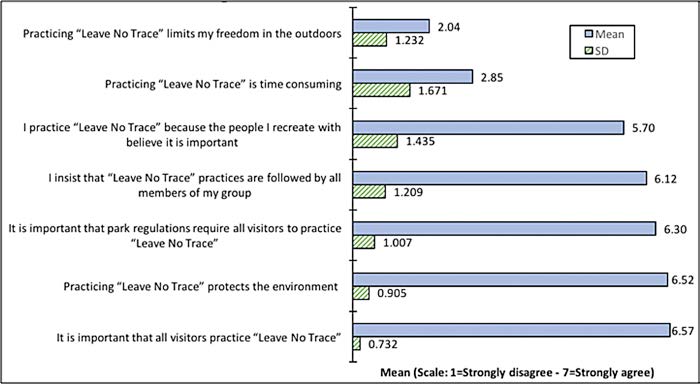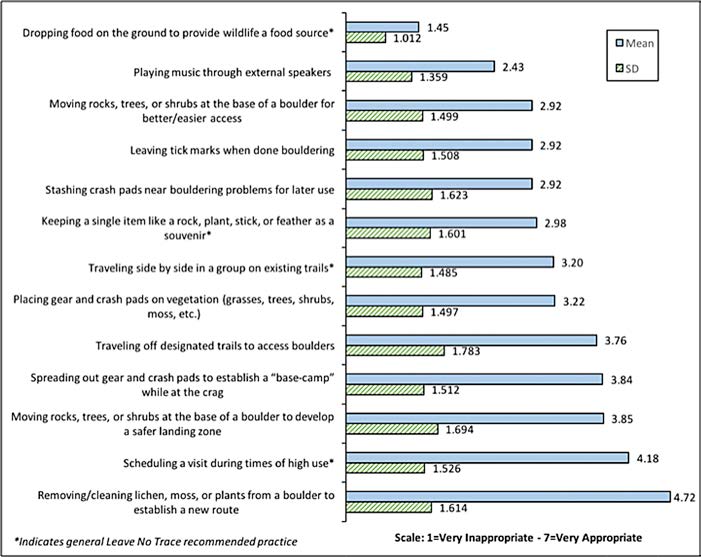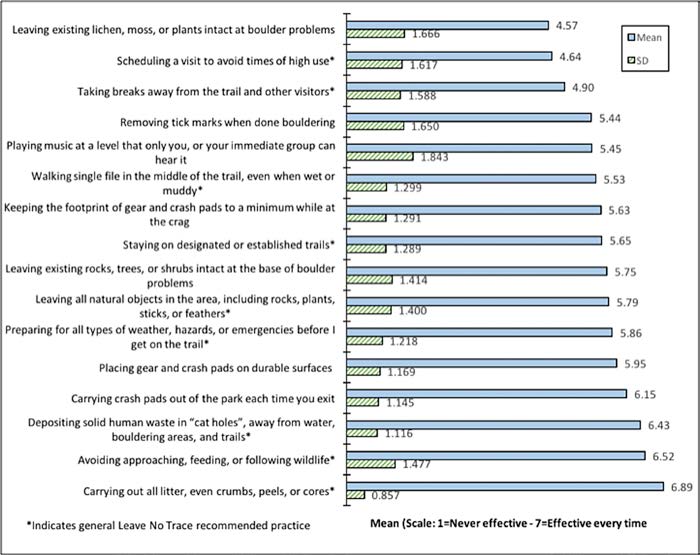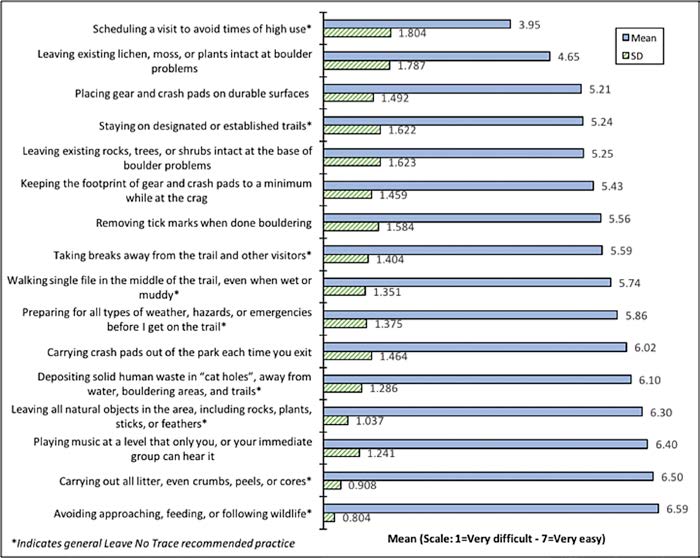Science & Research
December 2016 | Volume 22, Number 3
by FORREST SCHWARTZ, B. DERRICK TAFF, DAVID PETTEBONE, and BEN LAWHON
PEER REVIEWED
Abstract: Bouldering is a growing recreational activity, frequently occurring in fragile wilderness areas. As bouldering use increases, so too does the potential for ecological and social impacts. Leave No Trace–based educational strategies are the most prominent form of indirect management used to influence wilderness visitor behaviors. Given the growth of bouldering in wilderness and the lack of understanding regarding boulderers’ perceptions of minimum impact practices, the purpose of this study was to examine boulderers’ attitudes and perceptions of Leave No Trace in Rocky Mountain National Park. Results suggest that boulderers’ attitudes generally align with Leave No Trace recommended practices, although attitudes are less congruent with practices that are perceived as limiting to safety, access, and maintaining bouldering opportunities in the park. Findings indicate that global perceptions of Leave No Trace are positive and that educational communication strategies that target specific bouldering behaviors could minimize ecological and social impacts associated with bouldering. Results provide wilderness managers with baseline attitudinal data, which can be reevaluated in the future and monitored in conjunction with ecological data, after educational communication and outreach strategies have been deployed.
Recent research suggests that the majority of rock climbers in the United States, some two-thirds of the estimated 7.5 million recreational climbers, consider themselves to be boulderers or indoor/gym climbers (Outdoor Industry Association 2013). Bouldering is a recreational activity associated with climbing on small rock formations that are short enough in height that ropes and other climbing equipment are not used, given that heights of the climbing challenges rarely exceed 15–20 feet (5–7 meters). Instead of ropes for fall protection, boulderers rely on crash pads and fellow boulderers to act as “spotters.” The increase of the sport in parks and protected areas can be attributed to the limited amount of equipment needed (e.g., climbing shoes, crash pad, climbing chalk) and the increase in dedicated climbing- and bouldering-specific gyms and fitness centers over the past decade (The Access Fund 2006). As bouldering continues to gain in popularity and participation, more climbing opportunities are being discovered within both public and private lands, including wilderness areas. It therefore becomes increasingly important that park and recreation managers be aware of the ecological and social impacts associated with bouldering. Over the last decade, Rocky Mountain National Park (RMNP) has become an iconic bouldering destination, particularly in the Emerald Lake and Chaos Canyon areas.
In 2011 a bouldering guidebook was published, increasing awareness and visitation to the park’s vast boulder-ing resources, uniquely set within the stunning yet fragile alpine wilderness found within RMNP. Officially designated as wilderness in 2009, RMNP contains high alpine peaks exceeding 12,000 feet (3,658 m) and views of the Continental Divide that attract visitors from nearby urban cities and across the world (Pettebone 2013).
Like all outdoor recreation activities, bouldering has the potential to cause ecological degradation, such as vegetation loss, soil erosion, and resource modification; social impacts, such as user conflicts, crowding, and increased anthropogenic noise; and aesthetic impacts associated with residual climbing chalk on boulders. This is of particular concern in the wilderness environment where bouldering takes place in RMNP. Indirect management in the form of education is frequently applied to minimize ecological and social impacts in wilderness areas (Man-ning 2003). However, little is known regarding how boulderers perceive minimum impact behaviors such as those prescribed through the Leave No Trace Center for Outdoor Ethics (The Center).
The Center’s seven Leave No Trace Principles and the associated messages are the most prevalent minimum impact education strategy applied in parks and protected areas (Marion 2014), including RMNP. Over the years the principles of Leave No Trace have been adapted to address existing and emerging outdoor recreation use patterns. These adaptations have addressed specific activities, such as fishing and llama packing, as well as recreation settings and contexts, such as the Appalachian Trail, winter recreation, and international travel.
The emergence of outdoor bouldering introduces a new pattern of recreation use in parks and protected areas (e.g., the use of crash pads and climbing chalk, accessing areas typically not visited by other recreationists), calling for a need to examine the extent to which commonly practiced outdoor bouldering behavior aligns with Leave No Trace recommended practices. In order to deliver effective messaging campaigns about acceptable boul-dering behaviors in RMNP, there is need to first identify common use patterns that may be less congruent with Leave No Trace recommendations. If appropriately implemented, bouldering-specific Leave No Trace practices can reduce ecological and social impacts and improve visitor experiences by influencing behaviors.
It is a wilderness area manager’s responsibility to know the kinds and amounts of use that occur in the protected areas they oversee, and research can aid a manager’s understanding of the visitor use that occurs on their administered lands (Dawson, Cordell, Watson, Ghimire, and Green 2016; Hammitt, Cole, and Monz 2015; Pettebone 2013). Land managers influence the “setting” through their management approaches, in which a visitor’s experience takes place through decisions about recreational uses. In cases where uses are impactful, or have the potential to impact the ecological or social context of a wilderness area, managers may choose to engage in active management to accommodate recreation opportunities and mitigate associated impacts. However, knowledge about current use and resource conditions are necessary in order to ensure that decisions about active management, including conscious and deliberate lack of management, remedy impacts of concern (Pettebone 2013).
In general, a primary objective of the wilderness area manager is to strike a balance between satisfying public desires for recreational experiences without creating substantial irreversible losses of wildland resources (Hammitt, Cole, and Monz 2015). Given the rapid increase in bouldering, particularly in RMNP’s fragile high alpine wilderness, it is necessary for park managers to develop a greater understanding of boulderers’ attitudes and perceptions of Leave No Trace practices. This knowledge can improve communication strategies and influence climber behavior to better align with wilderness management objectives.
Previous research suggests attitudes to be an important driver of human behavior (Ajzen 1985; 1991). The Theory of Planned Behavior (TPB) is one of the most commonly applied theories in studies of human behavior (Ajzen 2011). Briefly, the TPB suggests that attitudes, along with beliefs, norms, and behavioral control, influence behavioral intent and ultimately behavior (Ajzen 1985; 1991). Based on this premise, researchers have provided evidence that to effectively change human behavior, efforts need to be directed at individuals’ attitudes, or the belief structures underlying those attitudes (Ajzen 1991; Ajzen and Fishbein 2005). Thus, utilizing the Theory of Planned Behavior as a theoretical framework, the purpose of this study was to examine the perceptions of boulderers in RMNP in effort to establish a baseline understanding of their attitudes and perceptions of Leave No Trace–related practices.
Methods
Semi-structured phone interviews with key stakeholders (e.g., RMNP climbing rangers, guidebook author, bouldering gym owners, Access Fund staff, Leave No Trace Center staff) informed the development of a quantitative survey. Respondents provided information about potential problem behaviors associated with bouldering, such as playing music through external speakers, stashing crash pads, impacting vegetation with crash pads, and leaving chalk tick marks. The quantitative survey examined boulderers’ attitudes toward general Leave No Trace practices, attitudes toward minimum impact practices specific to bouldering, and overall global perceptions of the Leave No Trace program.
Attitudes were measured through several batteries of questions that examined perceived appropriateness, effectiveness, and difficulty associated with practicing Leave No Trace–related behaviors. The attitudinal batteries included items related to the seven Leave No Trace Principles generally, and additional items related to bouldering specifically. The items related to the seven Leave No Trace Principles have been used in previous research (see Lawhon et al. 2013; Taff et al. 2014; Vagias and Powell 2010; Vagias et al. 2014).
Global perceptions of Leave No Trace as a program were evaluated by seven Likert-type items anchored from 1 = Strongly Disagree to 7 = Strongly Agree (see Figure 1). The global perception questions were located toward the end of the survey to eliminate potential bias associated with using the phrase “Leave No Trace” in any of the attitudinal batteries that preceded these items. The appropriateness of specific Leave No Trace recommended practices was measured using 13 Likert-type statements anchored from 1 = Very Inappropriate to 7 = Very Appropriate (see Figure 2). All of these statements are considered inappropriate behaviors under strict interpretation of Leave No Trace. The perceived effectiveness of Leave No Trace practices in minimizing impact in RMNP was examined using 16 Likert-type behavior statements – considered appropriate behaviors as interpreted through the lens of Leave No Trace (see Figure 3). These items were rated on a seven-point scale anchored from 1 = Never Effective to 7 = Effective Every Time. The perceived difficulty of practicing the same 16 behaviors as in the effectiveness battery was assessed on a seven-point scale anchored from 1 = Very Difficult to 7 = Very Easy (see Figure 4).
The survey was administered to boulderers in RMNP’s Chaos Can-yon and Emerald Lake areas during the summer of 2015. Sampling was stratified by weekday and weekend at Chaos Canyon across 17 sampling periods, and at Emerald Lake through 15 sampling periods, each spanning from 10 a.m. to 5 p.m. A total of n = 229 boulderers completed the survey, resulting in a 95% response rate.
Results
Sample Characteristics
Approximately 72% of the sample was male, with a mean age of 27. More than 96% of the respondents were US residents, and approximately 65% resided in the state of Colorado. The majority (~60%) of bouldering parties consisted of three or more people, and the overall mean group size was three. On average, respondents reported approximately seven years of previous bouldering experience, and greater than 62% of the sample reported to be of advanced to expert bouldering ability (based on the commonly used “V-scale” bouldering route grading standards). When asked where they initially learned to climb, 67% of respondents reported to have learned indoors in a gym, while 33% learned outdoors. Nearly 30% of respondents were bouldering in RMNP for the first time, and just under 50% had been bouldering in RMNP for one year or less.
Global Perceptions of Leave No Trace
Respondents reported overall high support for the Leave No Trace program (Figure 1). Mean values for the statements suggesting support for Leave No Trace were above 5.70, indicating that boulderers perceive Leave No Trace positively on a global level. For example, more than 90% of respondents answered with a “6” or “7” to the items Practicing Leave No Trace protects the environment (M=6.52) and It is important that all visitors practice Leave No Trace (M=6.57). This implies further that the majority of respondents perceive Leave No Trace to be an important approach to minimizing recreation-related impacts in RMNP. Moreover, the majority of respondents disagreed that Practicing Leave No Trace limits my freedom in the outdoors and that Practicing Leave No Trace is time consuming, indicating that Leave No Trace behaviors do not constrain the quality of outdoor recreation experiences.
Attitudes toward Leave No Trace Recommended Practices
Attitudes toward the appropriateness of the behaviors of interest were evaluated with nine bouldering-specific statements and four general Leave No Trace behavior statements (Figure 2). Attitudes toward appropriateness were found to be mostly congruent with the general Leave No Trace behavior statements, although they varied depending on the principle in question. For example, 90% of respondents (M=1.45) answered with a “1” or “2” to the item Dropping food on the ground to provide wildlife as a food source indicating the behavior to be considered highly inappropriate. The standard deviation for this item was also comparatively low, suggesting a higher level of agreement among respondents. Alternatively, the item Scheduling a visit during times of high use was evaluated as being slightly more appropriate, as 80% of respondents (M=4.18) scored the statement with a “4” or higher. This result is counter to what would be suggested of Leave No Trace-related recreation behaviors.
Regarding appropriateness of Leave No Trace–related behaviors specific to bouldering, attitudes generally aligned with recommended practices. However, results indicated less congruence with behaviors more specific to safety and accessing or maintaining bouldering opportunities in the park. The item Removing/cleaning lichen, moss, or plants from a boulder to establish a new route was assessed as somewhat appropriate, with 70% of respondents answering with a “4” or higher. Moreover, the item Traveling off designated trails to access boulders resulted in a mean of 3.85, thus perceived as inappropriate; however, this was a comparatively higher mean score than many of the other behavioral items that were specific to bouldering. Furthermore, the standard deviation of 1.78 suggested less agreement among respondents about the appropriateness of this behavior. Stashing crash pads near bouldering problems for later use, Leaving tick marks when done bouldering, and Playing music through external speakers were considered among the least appropriate bouldering-specific activities (M=2.92, 2.92, and 2.43 respectively).
Perceived Effectiveness
To assess perceived effectiveness of Leave No Trace recommended practices, respondents were asked to indicate the extent to which certain behaviors would reduce impact while bouldering in RMNP (Figure 3). Nine general Leave No Trace–related behavioral statements and seven items specific to minimum impact bouldering in RMNP were evaluated. All of the general Leave No Trace items were perceived as slightly to highly effective with scale means ranging from 4.64 to 6.89. Similar to the results of the appropriateness measures, Scheduling a visit to avoid times of high use was perceived to be the least effective of the behaviors in question (M=4.64). Carrying out all litter, even crumbs, peels, or cores was perceived to be the most effective of the general Leave No Trace statements (M=6.89). And the standard deviation of .857 suggested strong agreement among respondents regarding this behavior.
Leave No Trace–related behaviors specific to bouldering in RMNP were also all perceived as slightly to highly effective. In this case scale means ranged from 4.57 to 6.15. The statement Leaving existing lichen, moss, or plants intact at boulder problems was answered with a “4” or less by 53% of respondents, suggesting that this behavior was perceived as the least effective of the practices in question – a result similar to the findings in the appropriateness measures. Alternatively, Carrying crash pads out of the park each time you exit was perceived as the most effective of the bouldering-specific behaviors (M=6.15), and the comparatively lower standard deviation of 1.145 suggested fairly strong agreement among respondents.
Perceived Difficulty
Respondents were provided the same set of behavioral statements as in the effectiveness measures, but instead asked to rate the difficulty of performing each behavior while bouldering in RMNP (Figure 4). In the case of the general Leave No Trace behavioral statements, all but one (Scheduling a visit to avoid times of high use, M=3.95) resulted in a mean score above “5” on the scale, indicating the behaviors are perceived to be moderately to very easy to perform. Of the behaviors that scored above “5,” Staying on designated or established trails was perceived to be the most difficult (M=5.24).
In regard to the bouldering-specific Leave No Trace–related behaviors, all but one (Leaving exist-ing lichen, moss, or plants intact at boulder problems, M=4.65) resulted in a mean score of “5” or above. Of those behavioral items scoring above “5,” Placing gear and crash pads on durable surfaces and Leaving existing rocks, trees, or shrubs intact at the base of boulder problems were perceived as more difficult to perform (M=5.21 and 5.25 respectively). Alternatively, Carrying crash pads out of the park each time you exit was perceived as one of the easier behaviors to practice, with 77% of respondents answering with a “6” or “7.”
Discussion
The purpose of this study was to examine the perceptions of boulderers in Rocky Mountain National Park to establish a baseline understanding of their attitudes toward Leave No Trace recommended practices. These data provide insight into specific behaviors where attitudes align with Leave No Trace recommendations, and those practices specific to bouldering where attitudinal gaps exist. Results indicate that on a global level boulderers were highly supportive of the Leave No Trace message and corresponding behaviors. Overall, they reported positive perceptions of Leave No Trace and felt it is an important means of minimizing recreation-related impacts. However, attitudes toward some bouldering-specific behaviors were less favorable and merit additional attention. For example, Moving rocks or trees at the base of a boulder to develop a safer landing zone and the act of Removing lichen, moss, or plants from a boulder to establish a new route (a practice commonly referred to as “gardening”) received greater support relative to the other Leave No Trace practices being evaluated. These identified attitudinal gaps between bouldering practices and Leave No Trace recommendations, which advocate no or minimal site alterations, highlight opportunities to develop collaborative solutions for mitigating potentially impactful behaviors related to bouldering in the park.
It is recognized that bouldering, like all outdoor recreation activities, comes with an inherent set of impacts that in many cases are aesthetically obvious. Clearly boulderers should be conscious of these impacts and take measures to adopt practices that mitigate them (e.g., remove chalk tick marks, refrain from “gardening” on boulder problems, avoid creating new trails). However, it is important to recognize that many of these types of impacts are not entirely unique to bouldering. In other words, bouldering is not unlike many recreation activities that take place in wilderness, in that there is an inherent tension between recreational pursuits and wilderness character. For example, anglers often create informal trails in order to access desirable fishing locations, equestrian use can cause trail impacts that lead to erosion which is well documented in the recreation ecology literature, and overnight campers clear vegetation for tents and campsites (or agency has previously established a site by clearing vegetation for this purpose). However, managers often accept these recreation activities as “traditional” uses of wilderness and recognize the need to educate these users about Leave No Trace practices, monitor to understand changing resource conditions, and provide agency presence to enforce regulations to protect park resources.
With proactive interest to engage boulderers in the management process there is potential to develop specific minimum-impact practices associated with the activity. Research such as this provides insight to effective communication approaches to engage and educate this group in order to develop best messaging practices. There is need to develop a “standard” set of minimum impact bouldering principles. The Leave No Trace Center for Outdoor Ethics along with other stakeholder groups are currently in the process of developing these messages and materials (B. Lawhon, personal communication, May 26, 2016). Education and messaging efforts are being initiated in RMNP via signage, website, and direct ranger and park volunteer contact. Park staff have also begun, and continue, to collaborate with external agencies and constituent groups in outreach efforts. Of note, nearly 70% of respondents in this study indicated they first learned to climb indoors in a gym. This research suggests that park staff focus education and outreach efforts within the climbing gym industry. Finally, an important implication for wilderness stewardship is that the bouldering population tends to be composed primarily of a younger generation of users. It is important to not alienate this group of wilderness users but instead work with this community to help foster interest in wilderness protection amongst a new generation of wilderness stewards.
Conclusion
Wilderness managers must understand the perceptions of growing user-groups, such as boulderers, in order to develop management strategies that promote the protection of resources while maintaining quality recreational opportunities. This study found that boulderers’ attitudes toward common Leave No Trace practices generally aligned with recommended behaviors. However, a number of bouldering-specific practices were identified to be less congruent with Leave No Trace recommendations, indicating that opportunities exist to improve messaging efforts. Global perceptions of Leave No Trace were positive, suggesting that expansion of messaging and outreach specific to bouldering, in conjunction with the continued educational strategies currently promoted by the Leave No Trace Center and RMNP, could influence attitudes in a manner that better aligns with wilderness management objectives. Specifically, messaging could be crafted that focuses on the effectiveness and lack of difficulty associated with the practices currently perceived by some as limiting to bouldering opportunities. Finally, these results provide baseline data regarding attitudes toward Leave No Trace behaviors, which perhaps after the implementation of additional education strategies specific to bouldering behaviors can be monitored over time in conjunction with ecological conditions, to assess trends related to this growing wilderness activity.
Acknowledgments
The authors would like to acknowledge the staff at Rocky Mountain National Park and the Leave No Trace Center for Outdoor Ethics, as well as the key informants involved in the bouldering community for their support of this research.
FORREST SCHWARTZ is a PhD candidate in the Recreation, Park, and Tourism Management Department at Pennsylvania State University; email: fgs117@psu.edu.
DERRICK TAFF is an assistant professor in the Recreation, Park, and Tourism Management Department at Pennsylvania State University; email: bdt3@psu.edu.
DAVID PETTEBONE is the applied research coordinator of the Social Science Program for the National Park Service in Fort Collins, CO, USA; email: david_pettebone@nps.gov.
BEN LAWHON is the education director for the Leave No Trace Center for Outdoor Ethics in Boulder, CO; email: ben@lnt.org.
References
The Access Fund. 2006. Bouldering: Understanding and managing climbing on small rock formations. Retrieved September 10, 2014, from http://www.accessfund.org.
Ajzen, I. 1985. From intentions to actions: A theory of planned behavior. In Action-Control: From Cognition to Behaviour, ed. J. Kuhl and J. Beckman (pp. 11–39). Heidelberg, DE: Springer.
———. 1991. The theory of planned behavior. Organizational Behavior and Human Decision Processes 50(2): 179–211.
———. 2011. The theory of planned behaviour: Reactions and reflections. Psychology & Health 26(9): 1113–1127.
Ajzen, I., and M. Fishbein. 2005. The influence of attitudes on behavior. In The Handbook of Attitudes, ed. D. Albarracin, B. T. Johnson, and M. P. Zanna, eds. (pp. 173–221). New York: Psychology Press.
Dawson, C. P., K. Cordell, A. E. Watson, R. Ghimire, and G. T. Green. 2016. The US Wilderness Managers Survey: Charting a path for the future. Journal of Forestry 114(3): 298–304.
Hammitt, W. E., D. N. Cole, and C. A. Monz. 2015. Wildland Recreation: Ecology and Management. New York: John Wiley & Sons.
Lawhon, B., P. Newman, B. D. Taff, J. J. Vaske, W. M. Vagias, A. Bright, S. R. Lawson, and C. Monz. 2013. Factors influencing behavioral intentions for Leave No Trace behavior in Rocky Mountain National Park. Journal of Interpretation Research 18(1): 24–38.
Manning, R. E. 2003. Emerging principles for using information/education in wilderness management. International Journal of Wilderness 9(1): 20–27.
Marion, J. L. 2014. Leave No Trace in the Outdoors. Mechanicsburg, PA: Stackpole Books.
Outdoor Industry Association. 2013. Outdoor Participation Report 2013. Retrieved November 12, 2014, from http://outdoorindustry.org/images/researchfiles/ParticipationStudy2013.pdf?193.
Pettebone, D. 2013. Rocky Mountain National Park: Wilderness after 35 years. International Journal of Wilderness 19(1): 9–14.
Taff, B. D., P. Newman, W. M. Vagias, and B. Lawhon. 2014. Comparing day-users’ and overnight visitors’ attitudes concerning Leave No Trace. Journal of Outdoor Recreation, Education, and Leadership 6(2): 133–146.
Vagias, W. M., and R. B. Powell. 2010. Backcountry Visitors Leave No Trace attitudes. International Journal of Wilderness 16(3): 21–27.
Vagias, W. M., R. B. Powell, D. D. Moore, and B. A. Wright. 2014. Predicting behavioral intentions to comply with recommended Leave No Trace practices. Leisure Sciences 36(5): 439–457.




